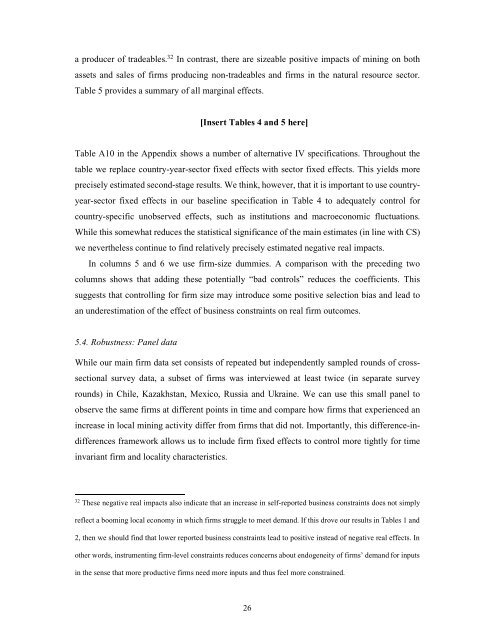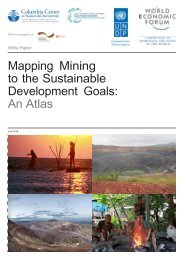Mining matters Natural resource extraction and local business constraints
2fCPiMQ
2fCPiMQ
You also want an ePaper? Increase the reach of your titles
YUMPU automatically turns print PDFs into web optimized ePapers that Google loves.
a producer of tradeables. 32 In contrast, there are sizeable positive impacts of mining on both<br />
assets <strong>and</strong> sales of firms producing non-tradeables <strong>and</strong> firms in the natural <strong>resource</strong> sector.<br />
Table 5 provides a summary of all marginal effects.<br />
[Insert Tables 4 <strong>and</strong> 5 here]<br />
Table A10 in the Appendix shows a number of alternative IV specifications. Throughout the<br />
table we replace country-year-sector fixed effects with sector fixed effects. This yields more<br />
precisely estimated second-stage results. We think, however, that it is important to use countryyear-sector<br />
fixed effects in our baseline specification in Table 4 to adequately control for<br />
country-specific unobserved effects, such as institutions <strong>and</strong> macroeconomic fluctuations.<br />
While this somewhat reduces the statistical significance of the main estimates (in line with CS)<br />
we nevertheless continue to find relatively precisely estimated negative real impacts.<br />
In columns 5 <strong>and</strong> 6 we use firm-size dummies. A comparison with the preceding two<br />
columns shows that adding these potentially “bad controls” reduces the coefficients. This<br />
suggests that controlling for firm size may introduce some positive selection bias <strong>and</strong> lead to<br />
an underestimation of the effect of <strong>business</strong> <strong>constraints</strong> on real firm outcomes.<br />
5.4. Robustness: Panel data<br />
While our main firm data set consists of repeated but independently sampled rounds of crosssectional<br />
survey data, a subset of firms was interviewed at least twice (in separate survey<br />
rounds) in Chile, Kazakhstan, Mexico, Russia <strong>and</strong> Ukraine. We can use this small panel to<br />
observe the same firms at different points in time <strong>and</strong> compare how firms that experienced an<br />
increase in <strong>local</strong> mining activity differ from firms that did not. Importantly, this difference-indifferences<br />
framework allows us to include firm fixed effects to control more tightly for time<br />
invariant firm <strong>and</strong> <strong>local</strong>ity characteristics.<br />
32<br />
These negative real impacts also indicate that an increase in self-reported <strong>business</strong> <strong>constraints</strong> does not simply<br />
reflect a booming <strong>local</strong> economy in which firms struggle to meet dem<strong>and</strong>. If this drove our results in Tables 1 <strong>and</strong><br />
2, then we should find that lower reported <strong>business</strong> <strong>constraints</strong> lead to positive instead of negative real effects. In<br />
other words, instrumenting firm-level <strong>constraints</strong> reduces concerns about endogeneity of firms’ dem<strong>and</strong> for inputs<br />
in the sense that more productive firms need more inputs <strong>and</strong> thus feel more constrained.<br />
26






